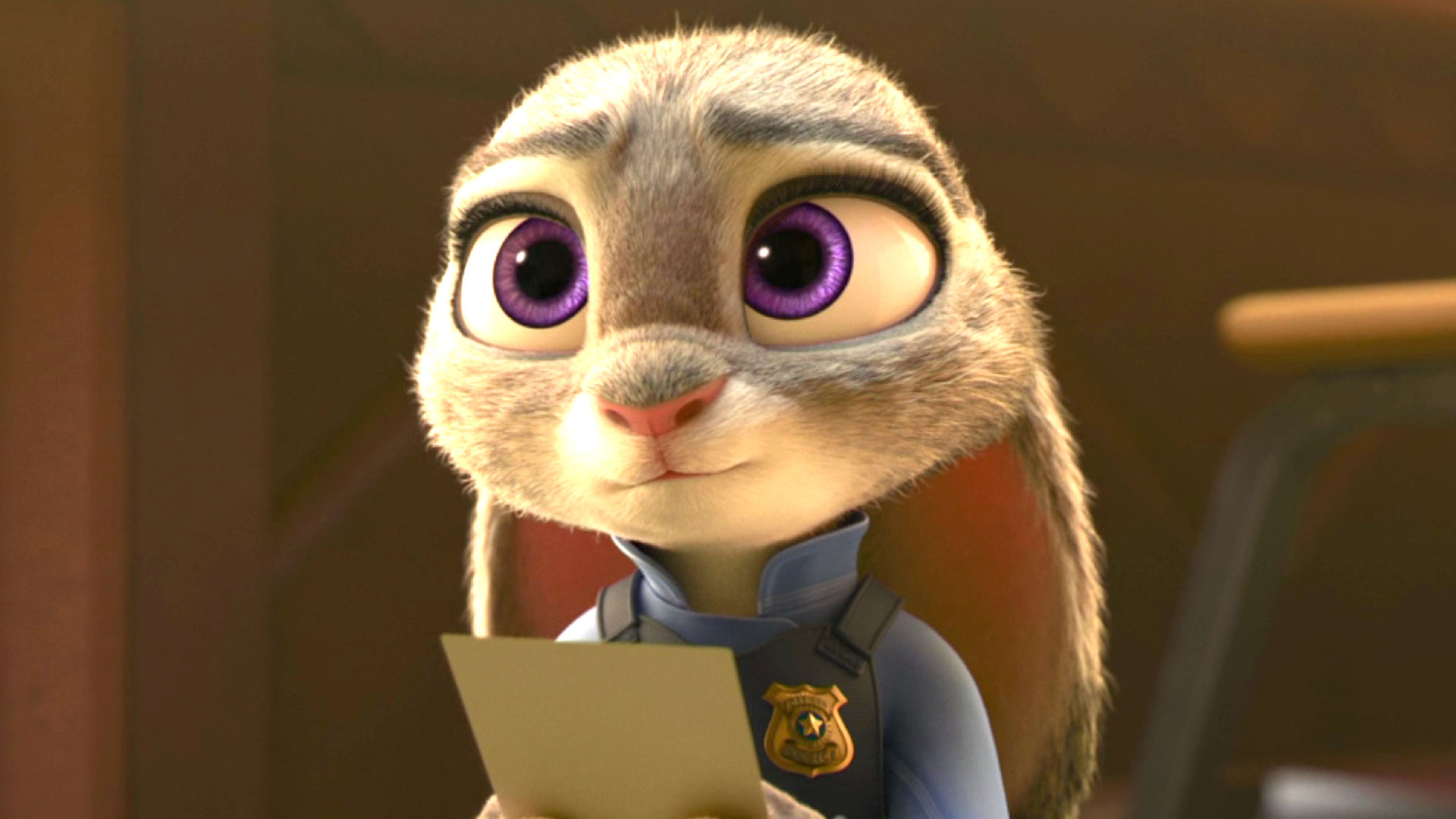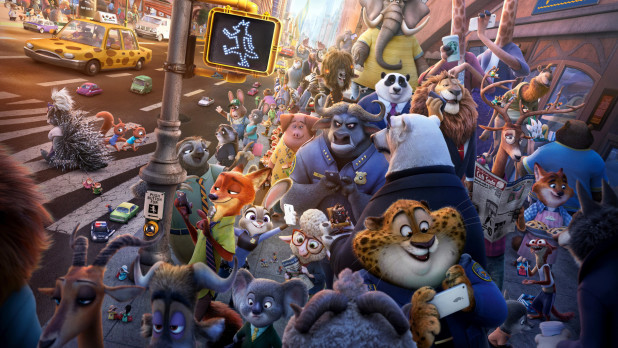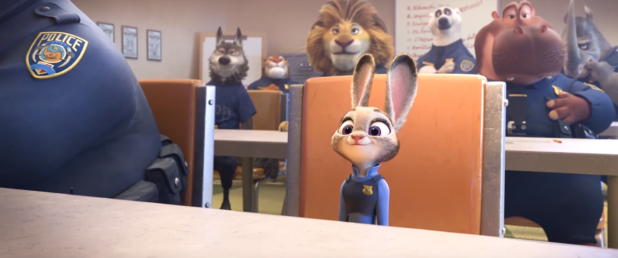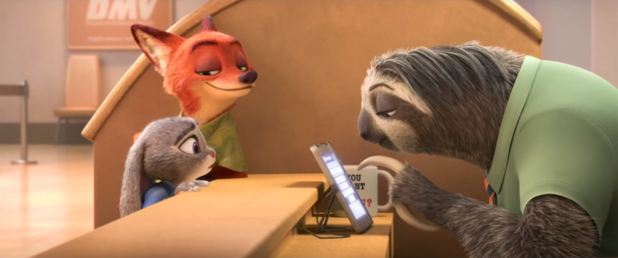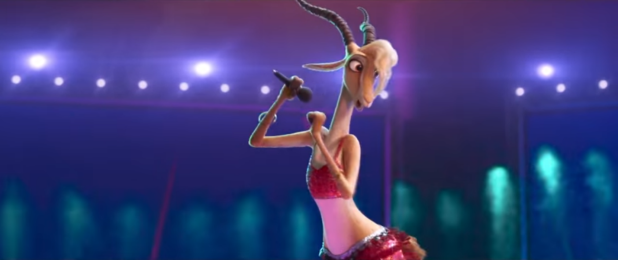Howe Abbott-Hiss
The Right Stuff
May 3, 2016
Zootopia is another attempt to propagandize for multiculturalism, coming from the same studio which once produced an uplifting allegory for traditional white identity and aristocracy. In line with the dominant elite view on race, it manages to simultaneously push wild-eyed optimism and a paranoid victim attitude. Considering that it met with very positive critical response, including praise for its political message, the subtitle might as well be This is What Our Elites Actually Believe.
As the title implies, the film depicts an unrealistic society inhabited by various animals. The heroine, Judy Hopps, is an effervescent rabbit from a rural area whose parents hope that she will become a carrot farmer like themselves. Their bluntly stated and cartoonish view is that you should not try new things because you might fail. Rejecting this view, Judy aspires to be a police officer, unmoved by their insistence that no bunny has ever held that title. A fox bully assaults her and tells her again of the mismatch between her species and her career aspirations, but she ignores this as well.
Police training for our heroine involves competing in a series of physical tests obviously designed for animals many times her size. At first she fails all of these, but she perseveres and eventually qualifies, apparently through sheer strength of will.
The multicult message continues when Judy gets ready to leave for Zootopia to begin her law enforcement career. Her parents display excessive concern over her possible future encounters with foxes, offering her fox repellent and even a taser to defend herself with. They remind her of her experience with the fox Gideon Grey who assaulted her years ago, but our heroine recites lines to the effect of “NAXALT” and “some of us are jerks too.”
When she first arrives in Zootopia full of enthusiasm, Judy finds that her new employer thinks very little of her abilities and assigns her to be a meter maid. Her low-expectation-having parents are very pleased at this, as it is a low-risk job, but despite strenuous effort on her part, she finds it humiliating. Our heroine abandons her post to pursue a criminal who has brazenly stolen some flower bulbs from a shop, and eventually apprehends him and recovers the goods. Despite this accomplishment, she is still not appreciated, and is even reprimanded for her efforts, but perseveres. Without permission, Judy declares to a desperate otter woman that she will find her missing husband and only manages by a stroke of luck to avoid getting fired for her insubordination.
As the nondiscriminatory language of the film would put it, a cynical con artist named Nick Wilde just “happens to be” a fox. Judy meets Nick early in the film and at first intervenes on his behalf with an elephant shopkeeper who wants to refuse service to him based on his species. She uses the threat of legal trouble for a health code violation to force the elephants to serve Nick and his tiny “son” a giant popsicle. Soon, however, she learns that Nick is a professional con man and his “boy” is just another adult criminal of a smaller species.
Despite the obvious personality mismatch, Judy and Nick end up cooperating to solve the case of the 14 missing predators the police are searching for, including the otter Judy has promised to find. They become friends in the process, and this leads to the fox confiding in Judy his experience of discrimination as a cub.
As a bright-eyed enthusiastic youngster, Nick had hoped to join an organization similar to the Boy Scouts. The organization had never had a fox member, and although they invited him to join, the established members had no real intention of accepting him. After letting him recite his oath, they tied a muzzle over his snout and mocked him for his stupidity in thinking they would ever trust a fox.
Nick then recounts how he consciously decided that if others saw him as untrustworthy, he might as well act that way. Now an adult, he had bragged earlier in the film that he had been running scams every day since the age of 12. There was no mention of previous antisocial tendencies. The accusation that others’ rejection can turn an otherwise respectable person into a professional lowlife is of course paranoid, but familiar to anyone who has heard the terms “marginalized” or “stereotype threat.” The fox serves as an expression of the external locus of control so common among dysfunctional people.
The victim mentality is not limited to Nick’s story; the Wikipedia page on this movie uses the phrase “species-supremacist conspiracy” and this is not an exaggeration. We are expected to believe that Assistant Mayor Bellwether, a sheep, is conspiring with others to make it look like predators are actually dangerous. Her aim is to keep herself in power by spreading terror among the prey population and leading some kind of action against the predators in which her side will be “unstoppable.” The prey outnumber the predators at least nine to one, so this is clearly a statement about the supposed persecution of minorities. Viewers will also be familiar with the attempt to delegitimize fear of out-groups by portraying such feelings as simply a tool for wicked politicians.
Further, the means of the conspiracy are laughable. The premise of the film is that predators and prey are no longer actually predators and prey in terms of their behavior. Instead they now peacefully coexist, and the times of hunting and being eaten are thousands of years in the past. The conspirators, however, have developed and weaponized a drug which causes the target to revert to a savage state. Those affected do indeed act like ravenous predators and apparently even lose their ability to speak.
Blaming external racist forces for degeneracy in one’s own group should be a familiar concept to American viewers. This plot point is reminiscent of conspiracy theories about the CIA inventing and/or distributing crack cocaine to keep the Black man down, or similar popular theories concerning HIV. The seminal 1944 title An American Dilemma by the Swedish sociologist Gunnar Myrdal accused White prejudices of encouraging low standards of morality among Blacks, which in turn reinforced White prejudices, and so on in a vicious cycle.
Of course, today even the implication that there are different standards of morality between races or nationalities would be dismissed as racist. Other than of the victims of the conspiracy, there is no mention in the film of any actual difference in values or behavior between contemporary predators and prey animals.
However, the differences between species in Zootopia are dramatic, not only in size and shape but in some aspects of behavior. The sloths who form the staff of the DMV are as slow as actual sloths, even in their speech. There is no pretense of equality in this context; Nick even sarcastically asks Judy if she thinks that someone must be slow just because he is a sloth. Integration of sloths into rabbit or sheep classrooms would obviously be absurd.
Mixing between species is similarly extreme. In one shot the viewer can distinguish seven species with no two of the same type. Shrews do at least have residential segregation, living in a smaller-scale neighborhood, and there are different transportation systems for hamsters and hippos, but the shrew crime boss does not stick with his own kind; he employs polar bears as thugs. The suggestion that groups this different would be so willing to mix seems particularly desperate on the part of the filmmakers.
The film’s denunciation of racism is partly based on attempts at humor, which is an appropriate choice for propaganda. Judy praises Nick as “articulate” and he responds by complimenting her on how “non-patronizing” she is, highlighting her “racism.” Nick touches the sheep assistant mayor’s wool without her knowledge, comically amused by how fluffy it is. Judy reprimands him to the effect that “you can’t just touch a sheep’s wool.” She makes another reference to the racial sensitivities of American Blacks when she explains that a bunny can call another bunny cute, but when another animal does it, it is offensive.
The portrayal of “racist” characters is not as vitriolic as social justice warriors might like, but of course still fits with the overall agenda. While some “prejudiced” characters such as the elephant storekeeper and the young Gideon Gray are portrayed as hostile, the racist parents are portrayed as earnest and good-natured yet ignorant. Judy is to some degree portrayed the same way, when she innocently suggests that the basis of the predators going savage might be something in their biology. The results are not harmless though, as she triggers a wave of “xenophobia” against predators. Nick makes a great show of being offended by her racist thoughts, even testing her to confirm that she is in fact afraid of him, and she resigns in shame.
Zootopia makes a weak attempt at being less than utopian; Judy’s original expectations of a city where everyone gets along are shown to be overly optimistic, which she ultimately admits in a voiceover at the end of the film. The attempts at justifying continued faith in multiculturalism come off as desperate, though. Judy recites slogans such as “real life’s a bit more complicated than a slogan,” adding that the “glass [is] half full” and “we all have a lot in common,” but she does not sound as though she actually believes it. Of course, no one ever presents any particular reason to believe it; those who do not are simply not presented as reliable sources.
The film ends with a scantily clad gazelle performing a degenerate pop song by the Colombian singer Shakira which further highlights the underlying mindset. The lyrics of “Try Everything” celebrate mindless optimism and seem to be intended as a cheap form of therapy for someone who has a crippling fear of failure, reassuring them that “nobody learns without getting it wrong” and “sometimes we come last but we did our best.”
The proper response to failure, then, which of course is the norm for the multiculturalist project, is to repeatedly “start again.” Rather than making strenuous efforts toward any practical goal, you should be proud of achievements like having “filled your heart with love.” The singer’s expectation for the future is one that sounds very familiar to redpilled inhabitants of a multicult society, though not in the way the writers intended:
I’ll keep on making those new mistakes / I keep on making them every day /
Those new mistakes /
Try everything
